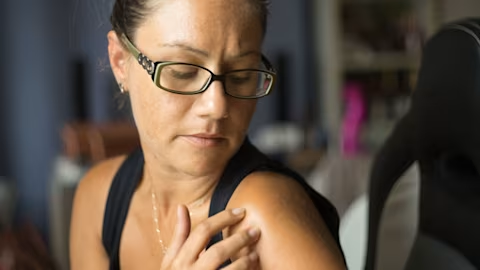Stay skin-safe: a guide to skin cancer self-checks
Catching skin cancer early makes all the difference.

Catching skin cancer early makes all the difference – the sooner it’s found, the simpler the treatment and the better the chances of avoiding surgery, scars or serious risks.
For skin cancer prevention, knowing your own skin is one of the best steps you can take. Most skin cancers are first spotted, opens in a new tab by the person themselves or someone close to them, which prompts them to go get a professional skin check. By keeping an eye on your skin and knowing what’s normal for you, you’re in a great position to notice any new or unusual spots quickly.
What is skin cancer and who is at risk?
Skin cancers, opens in a new tab occur when skin cells grow abnormally, often due to too much exposure to ultraviolet (UV) radiation from the sun. The main types of skin cancer are basal cell carcinoma (BCC), squamous cell carcinoma (SCC), and melanoma – the most dangerous.
While anyone can get skin cancer, it is more common in older people, people with fair or freckled skin and those with a family history.
Since Australia has one of the highest rates of skin cancer in the world, with more than 2,000 Aussies dying each year, opens in a new tab from the disease, getting into the habit of regularly checking your skin is vital.
Types of skin cancers to be aware of
Melanomas may appear, opens in a new tab as a new spot or an existing spot that changes in colour, size or shape. While melanomas usually occur on parts of the body that have been sunburned, they can appear in places not normally exposed to the sun, such as between the toes or the soles of the feet. You can follow the ABCDE method (below) to help identify melanomas.
Nodular melanoma, opens in a new tab looks different to regular melanoma. They are raised, firm to touch and even in colour. Nodular melanomas may be red, pink, brown or black, and they grow quickly – see your doctor immediately if you notice these changes as this can be life threatening.
The most common form of skin cancer, opens in a new tab, BCC often appears as a red, pale or pearly lump or scaly area that may ulcerate or fail to heal. They’re usually slow-growing and appear on areas of the body with high sun exposure – and though they’re the least dangerous form of skin cancer, you still need to see your healthcare professional if you notice these changes.
Squamous cell carcinoma (SCC) usually appears on parts of the skin that have had sun exposure as thickened, red, scaly patches. They may bleed easily, crust or ulcerate. If you notice any of these changes, visit your doctor, especially if you notice a scab that hasn’t healed in two months as this could be SCC, opens in a new tab.
Freckles vs moles
Both moles, opens in a new tab and freckles appear as darker spots on the skin, but while moles are usually raised, freckles are flat. In both, the colour is due to melanin, which can darken with sun exposure, and moles occur when pigment-containing skin cells (‘melanocytes’) form a cluster. While skin cancer self-checks are important, do keep in mind that not all spots are cancerous – and most moles are harmless. However if you notice something different, suspicious or just want peace of mind, it’s best to speak with your doctor.
Step-by-step guide for a self-skin check
Performing a self-skin check is easy and all you need is a room with plenty of light, a full-length mirror and either a handheld mirror or a partner/loved one to help. (You can return the favour once they’re done!)
Undress completely and, making sure you have good light, stand in front of your full-length mirror. Have your handheld mirror (or helper) at the ready.
Make sure you check your entire body, including areas that are not often (if ever) exposed to the sun, such as between the fingers and toes, the soles of the feet and under the fingernails. Use a mirror or ask your partner to check hard-to-see spots like your back and scalp.
As you’re checking your skin in the mirror, keep an eye out for new spots, freckles or moles, as well as any changes in colour, size or shape of existing spots, bleeding spots or moles and freckles that look different to the others.
Look for the ABCDE of melanoma changes – asymmetry, border, colour, diameter and evolving.
A is for asymmetry. Look for spots that are asymmetrical, not round
B is for border. Look for spots with uneven borders
C is for colour. Look out for spots with an unusual or uneven colour
Dis for diameter. Look for any spots that have increased in size and are larger than 7mm
E is for evolution.
Pay attention to any changes to the spots on your skin and if you see anything evolving, see your doctor as soon as possible. It may just save your life.
How often should I perform a self-skin check?
Check your skin regularly – say every six months – and get a skin check from a health professional annually. Become familiar with any pigmented lesions. If there’s a change in a lesion or it's new, then get it checked out and ask the person helping you to check if it’s difficult to see spots. It’s also not a bad idea to take photos each year of large moles – that way you can document and compare.
When should I speak with a doctor?
If you do notice a new mole or spot on your skin, see any changes to any existing spots or simply have any concerns about the spots on your skin, be sure to book a visit with your GP as quickly as possible. They can identify whether a spot is harmless or needs closer attention. If the lesion isn’t removed or biopsied and you’re still concerned, don’t be afraid to get a second opinion.
Please note the information in this article is general in nature and should not replace personalised advice given by your health professional.

How improving your gut health can help support your immune system
70 per cent of our immune function is centred in the gut

How to have a healthier relationship with alcohol
Find a balance with healthier drinking habits.

7 ways to get healthy on a budget
Here are a few ways to get healthy without breaking the bank